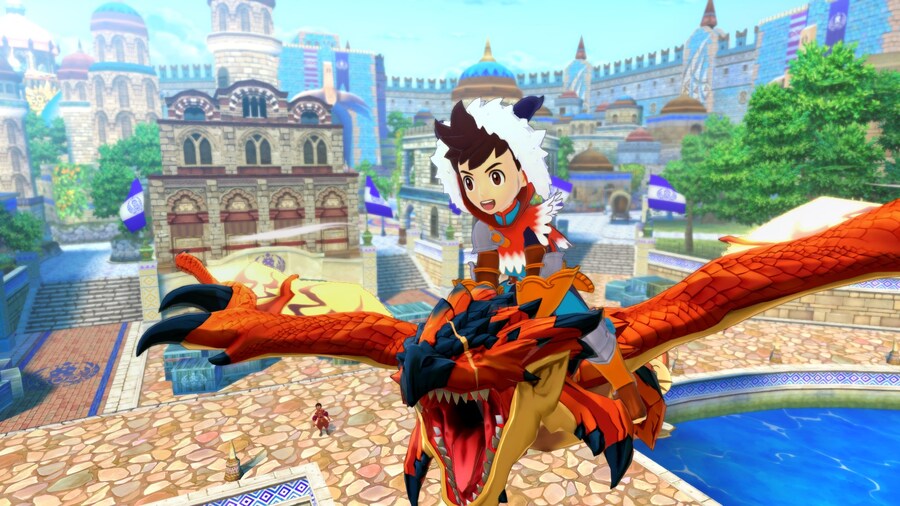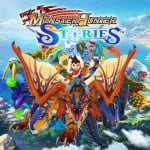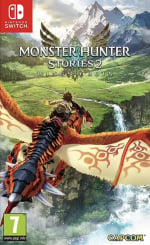
The Nintendo 3DS had plenty of incredible exclusives and in its heyday, a lot of those were in the Monster Hunter series. One gem that truly stands out from its no-glasses-3D siblings is Monster Hunter Stories. Developed as a collaboration between Capcom and Marvelous, this turn-based RPG was quite a massive departure in comparison to anything that's come before and is highly regarded by those that did play it. However, Stories was overlooked by many at the time as it was dealt the unfortunate hand of launching six months after the console that would replace the 2DS and 3DS, the Nintendo Switch.
Flash forward to the year 2024, and not only has a Switch sequel to Stories released, but that first game that fans loved so much is finally making its way to Switch, too. We had the chance to send off a few questions to the Monster Hunter Stories team at Capcom and the game's producer, Yoshihiro Akira, was kind enough to give us his insight on the game's co-development with Marvelous, 3DS-exclusive features, and what it's like bringing this game to a new audience.
Nintendo Life: How did the idea for a spin-off, turn-based RPG in the Monster Hunter series originally come about? Was this a magical elevator pitch from someone at Marvelous?
Yoshihiro Akira, Producer: For the first month or so of development, we were unable to break from the established convention of Monster Hunter as an action game, and we worried a lot about how to illustrate an "adventure with monsters" through the action.
A turn-based RPG that does not require difficult controls was highly compatible and feasible from a systemic standpoint, and production proceeded relatively smoothly once we began considering an RPG. However, there was a lot of trial and error until we came up with the "Three Attack Types" for the battle system, and with the help of Marvelous' suggestions, we were able to achieve the current game style.
How has it been working with Marvelous on the Stories series? What duties does Capcom and Marvelous each hold when it comes to co-developing a game like this?
The game was produced in-house at Capcom up to the prototype stage, and from there we proceeded with the construction and production of the game systems, drawing on Marvelous' experience with RPG development.
Capcom's role was to manage the quality of the Monster Hunter series and supervise the setting of the game, both of which were very demanding, and I still remember the hard work that Marvelous put in. I believe that this was worth it though, as we were able to create a unique and high-quality RPG.

Monster Hunter Stories was quite graphically impressive to have launched on 3DS, but anyone playing on a non-New 3DS could see a bit of stuttering here and there. What kind of performance can we expect this time around on Switch?
Since we’re bringing Monster Hunter Stories to a development environment based on its sequel, we hope you will feel the performance is similar to Monster Hunter Stories 2: Wings of Ruin.
The 3DS itself was home to some really unique features, which Monster Hunter Stories made full use of! Are some of these elements like StreetPass Dungeons and scanning player QR codes with the camera being reworked for Switch? Can you talk about that process if so?
Functions created specifically for the Nintendo 3DS have not been ported to other platforms.
Beyond the graphical upgrade, what other differences can newcomers or fans of the series expect to see between the 3DS and Switch versions of Monster Hunter Stories?
The most significant new element is that the game is now fully voiced in English and Japanese. This makes it easier to become emotionally involved in the game than it originally was on the Nintendo 3DS or smartphone versions, and we believe that this will allow players to more deeply enjoy the story of this title.
Another aspect is the Museum. This features more than 200 pieces of artwork showing the behind-the-scenes development of the game and developer comments providing insight into their thoughts when designing the original game. This release also includes character designs that did not make it into the original version, so this is one of the new features you can look forward to. You can also listen to the music tracks in the Museum mode, so we hope you enjoy!
The Nintendo fan inside of all of us is curious to know if the Link and Epona-themed Legend of Zelda DLC from the first game will be making the leap from 3DS to Switch as well?
Collaboration contents from outside Capcom will not be carried over into this release.
Does the team have any advice for anyone picking this game up for the first time?
The two titles in the Monster Hunter Stories series are RPGs created so that even those who aren’t experienced with action games can enjoy the world of Monster Hunter. They are designed to be played by a wide range of people, including those who enjoy RPGs (especially turn-based RPGs) and those who like to raise their characters.
Monster Hunter Stories 2: Wings of Ruin takes place four years after Monster Hunter Stories, and the worlds are connected, with the same characters appearing in both games. We hope you will play both titles, paying attention to the characters who have grown over the course of the series.
Players who have played Monster Hunter Stories in the past will be able to enjoy it again with English and Japanese full voice-over and a Museum Mode. And of course, Monster Hunter players will also be able to enjoy it to the fullest, so we hope you will give it a try!

We appreciate Yoshihiro Akira for taking the time to answer our questions. Stay tuned for our full review of Monster Hunter Stories when it launches on Switch on the 14th of June, and in the meantime, you can read our hands-on preview here.







